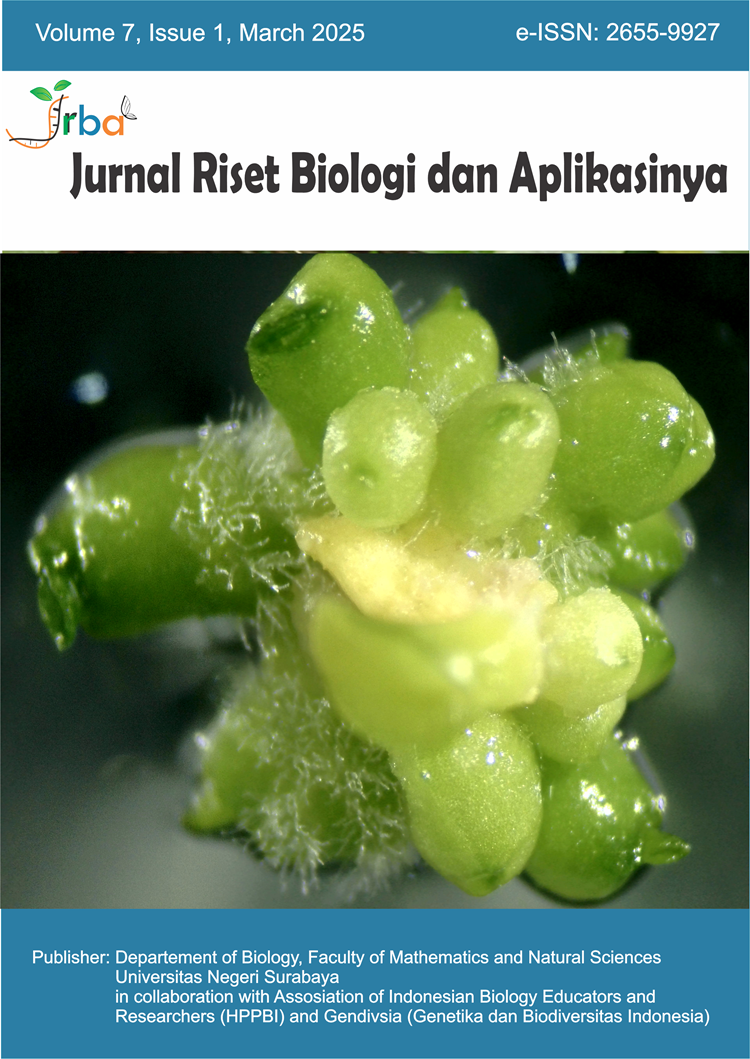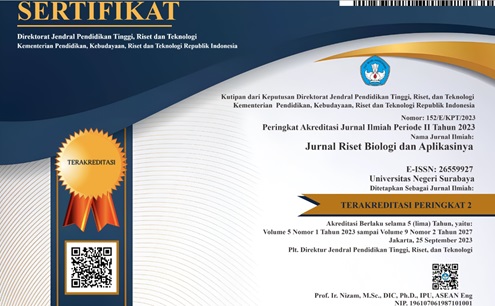Characterization and Molecular Identification of Lipolytic-bacterial Isolates Forming Biofilm on Polyethylene Plastic
DOI:
https://doi.org/10.26740/jrba.v7n1.p57-65Abstract
Polyethylene (PE) plastic is one of the most widely used for multiple purposes and leading the environmental problems. Lipolytic bacteria are promising agents to reduce the plastic waste. The dry weight of PE plastic was reduced by 33 % in the Winogradsky's column after 45 days of incubation. However, the lipolytic bacteria responsible for those reduction was unknown. This study aimed to characterize and identify the potential lipolytic bacterial isolates forming biofilm on polyethylene PE plastics. Samples of lipolytic bacterial isolates were screened on tributyrin selective media based on the formed clear zone. Moreover, the 16S rRNA genes of the two most potential lipolytic bacterial isolates were amplified. Then, the amplicons of the 16S rRNA gene were sequenced. This study found two potential lipolytic bacteria isolates, AB A-2 and AB M-3, which had the characteristics of round colonies, wavy edges, convex surfaces, and milky white color. The two isolates are gram-positive and have the shape of Coccobacillus cells. The molecular identification showed that AB A-2 isolate was Bacillus sp., while AB M-3 isolate was Bacillus amyloliquefaciens. This finding contributes to novel bacterial isolates that potentially overcoming the plastic waste problem.
References
Abidin, N., Wahdaniar, Febrianti, N., & Syarifah, S. M. (2023). Eco-Friendly Plastic Waste Decomposer. Bincang Sains dan Teknologi, 2(2), 63-71. https://doi.org/10.56741/bst.v2i02.339. [Indonesian]
Akihary, C. V., & Kolondam, B. J. (2020). The Utilization of 16S rRNA Gene as a Bacterial Identification Device for Research in Indonesia. Pharmacon Jurnal Ilmiah Farmasi, 9(1), 16-22. https://doi.org/10.35799/pha.9.2020.27405. [Indonesian]
Al-Shuhaib, M. B., & Hashim, H. O. (2023). Mastering DNA Chromatogram Analysis in Sanger Sequencing for Reliable Clinical Analysis. Journal of Genetic Engineering and Biotechnology, 21(115), 1-12. https://doi.org/10.1186/s43141
Arwini, N. P. D., (2022). Plastic Waste and Efforts to Reduce Plastic Waste Generation. Vastuwidya, 5(1), 72-82. https://doi.org/10.47532/jiv.v5i1.412. [Indonesian]
Chairunnisa, Riyanto, & Karim, A. (2019). Isolation and Test of Lipolytic Bacteria in Oil Degradation in Oil Palm Liquid Waste in Marihat Plantations. Pematang Siantar. Jurnal Ilmiah Biologi UMA, 1(2), 44-52. https://doi.org/10.31289/jibioma.v1i2.155. [Indonesian]
Deglas, W. (2023). Pengaruh Jenis Plastik Polyethylene (PE), Polypropylene (PP), High Density Polyethylene (HDPE), dan Overheated Polypropylene (OPP) terhadap Kualitas Buah Pisang Mas [Effect of Polyethylene (PE), Polypropylene (PP), High Density Polyethylene (HDPE), and Overheated Polypropylene (OPP) Plastics on the Quality of Mas Banana Fruit]. Agrofood Jurnal Pertanian dan Pangan, 5(1), 33-42. https://jurnal.polteq.ac.id/index.php/agrofood/article/view/134.
Ervina, E., Ekowati, C. N., & Sumardi. (2020). Lipolytic-screening of Bacillus Genera as Biocontrol Candidate in Coffee Plantation. Jurnal Biologi Eksperimen dan Keanekaragaman Hayati (J-BEKH), 7(1), 31-34. https://doi.org/10.23960/jbekh.v7i1.12.
Fazri, M., Kartika, A. I., Darmawati, S., & Ethica, S. N. (2019). Isolation and Molecular Identification of Staphylococcus epidermidis Bacteria in Shrimp Shrimp (Penaeus monodon) post-fermentation 24 Hours based on 16S rRNA Gene Sequence. Prosiding Seminar Nasional Mahasiswa Unimus, 2. https://prosiding.unimus.ac.id/index.php/mahasiswa/article/view/46.
Halim, S. I., & Rahayu, T. (2024). Polystrene (PS) Degrading Lipolytic Bacteria Screening from Bonoloyo TPU, Makam Haji TPS, and Bengawan Solo River. Bioscientist Jurnal Ilmiah Biologi, 12(1), 1178-1193. https://doi.org/10.33394/bioscientist.v12i1.11428
Intan, K., Diani, A., & Nurul, A. S. R. (2021). Antibacterial Activity of Cinnamon (Cinnamomum burmanii) against the Growth of Staphylococcus aureus. Jurnal Kesehatan Perintis, 8(2), 121-127. https://doi.org/10.33653/jkp.v8i2.679
Khairani, & Manalu, K. (2023). Isolation and Identification of Lipolytic Bacteria from Palm Oil Liquid Waste (Elaeis quineensis Jacq.). Bioedusains Jurnal Pendidikan Biologi dan Sains, 6(1), 1-13. https://doi.org/10.31539/bioedusains.v6i1.5285. [Indonesian]
Kolsi, I. Z., Mahmoud, A. B., & Barazie, R. A. (2023). Bacillus amyloliquefaciens: Harnessing Its Potential for Industrial, Medical, and Agricultural Applications-A Comprehensif Review. Microorganism, 11(2215), 1-19. https://doi.org/10.3390/microorganisms11092215.
Luo, L., Zhao, C., Wang, E., Raza, A., & Yin, C. (2022). Bacillus amyloliquefaciens as An Excellent Agent for Biofertilizer and Biocontrol in Agriculture: An Overview for its Mechanisms. Microbiological Research, 259(127016), 1-10. https://doi.org/10.1016/j.micres.2022.127016.
Mandiri, L. H., Rahayu, T., Tyastuti, E. M., & Sidiq, Y. (2023). Screening of Lipolytic Bacteria from Cemetery Soil. Bioeduscience, 7(3), 358-364. https://doi.org/10.22236/jbes/12686
Mogot, R., Anom, I D. K., & Kumajas, J. (2020). Dry Distillation of Low-Density Polyethylene (LDPE) Plastic Waste. Fullerene Journal of Chemistry, 5(1), 5-9. https://doi.org/10.37033/fjc.v5i1.131. [Indonesian]
NauE, D. A. B., Karneli, Syailendra, A., Syafitri, I., Wulandari, S., & Julianti, W. (2022). Beetroot (Beta vulgaris L.) as an Alternative to Safranin in Gram Staining. Husada Mahakam Jurnal Kesehatan, 12(1), 19-24. https://doi.org/10.35963/hmjk.v12i1.285. [Indonesian]
Noer, S. (2021). Molecularly Bacterial Identification Using 16S rRNA. EduBiologia, 1(1), 1-6. http://dx.doi.org/10.30998/edubiologia.v1i1.8596[Indonesian]
Nurzhulian, V. M., Sulistyaningtyas, A. R., & Ethica, N. (2021). Characterization of Lipolytic Bacteria Bacillus sp. in Wadi Digestive Organs of Eel (Anguilla sp.). Pro Food Jurnal Ilmu dan Teknologi Pangan, 7(2), 59-67. https://doi.org/10.29303/profood.v7i2.205. [Indonesian]
Oktavia, D. A., & Wibowo, S. (2016). Filtration and Identification of Lipolytic Bacteria Isolated from Surimi Treatment Wastewater and Crab Canning. JPB Kelautan dan Perikanan, 11(2),147-158. http://dx.doi.org/10.15578/jpbkp.v11i2.262. [Indonesian]
Oktavia, R., Nurcahyani, E., Wahyuningsih, S., & Sumardi. (2022). Ability of Bacillus sp. as Bioremediation of Pollutants. Jurnal Bioterdidik: Wahana Ekspresi Ilmiah, 10(2), 110-125. http://dx.doi.org/10.23960/jbt.v10i2.23919. [Indonesian]
Pertiwi, N. P. D., Mahardika, I. G. N. K., & Watiniasih, N. L. (2015). DNA Amplification Optimization Using PCR (Polymerase Chain Reaction) Method in Coral Fish of the Family Pseudochromidae (Dottyback) for Molecular Species Identification. Jurnal Biologi, 19(2), 1-5. http://dx.doi.org/10.13140/RG.2.2.27883.34083. [Indonesian]
Rahayu, T., Sidiq, Y., Harismah, K., Santhyami. (2024). Biodegradation of Plastics by Lipolytic Bacterial Mixture in Winogradsky Column. Berita Biologi, 23(3), 489-501. https://doi.org/10.55981/beritabiologi.2024.5706. [Indonesian]
Ratnawati, S. (2020). Processing of Plastic Waste into Alternative Fuels in the Form of Grounded (Pertalastic) Through Pirolysis Process in Science Laboratory of MTsN 3 West Aceh. Indonesian Journal of Chemical Science and Technology, 3(1), 8-16. https://doi.org/10.24114/ijcst.v3i1.18310.
Remijawa, E. S., Rupidara, A. D. N., Ngginak, J., & Radjasa, O. K. (2020). Isolation and Selection of Extracellular Enzyme-Producing Bacteria in Mangrove Soil at Noelbaki Beach. Jurnal Enggano, 5(2), 164–180. https://doi.org/10.31186/jenggano.5.2.164-180. [Indonesian]
Rini, H. S., Tyastuti, E. M., Sidiq, Y., & Rahayu, T. (2023). Screening for Lipolytic Bacteria from Bonoloyo Cemetery, Surakarta. Jurnal Pembelajaran dan Biologi Nukleus, 9(3), 496-505. https://doi.org/10.36987/jpbn.v9i3.4944. [Indonesian]
Royanti, V., Handayani, K., Ekowati, C. N., & Sumardi. (2023). Isolation and Characterization of Lipolytic Bacillus from Liwa Botanical Garden Soil. Gunung Djati Conference Series, 18(2023), 40-45. https://conferences.uinsgd.ac.id/index.php/gdcs/article/view/1096. [Indonesian]
Simamora, C. J. K., & Sukmawati. (2020). Identification and Characterization of Crude Extract Activity of Lipase Enzyme Isolate LPTK19 Lipolytic Bacteria Originating in Rubber Seed Tempeh. Median, 12(1), 28-37. http://doi.org/md.v12i. [Indonesian]
Sriningsih, A., & Shovitri, M. (2015). Potential of Pseudomonas Bacteria Isolate as Plastic Degrader. Jurnal Sains dan Seni, 4(2), 67-70. http://dx.doi.org/10.12962/j23373520.v4i2.13495.[Indonesian]
Susanto, H. (2016). Pemeriksaan Protozoa Helminthes. Depok: PPPPTK Bisnis dan Pariwisata
Talaro, K. P., & Chess, B. (2018). Microbiology Basic Principles. New York: McGraw-Hill Education.
Tamura, K., Stecher, G., & Kumar, S. (2021). MEGA 11: Molecular Evolutionary Genetics Analysis Version 11. Molecular Biology and Evolution, 38(7), 3022-3027. https://doi.org/10.1093/molbev/msab120
Tanasupawat, S., Phoottosavako, M., & Keeratipibul, S. (2015). Characterization and lipolytic activity of lactic acid bacteria isolated from Thai fermented meat. Journal of Applied Pharmaceutical Science, 5(3), 006-012. https://dx.doi.org/10.7324/JAPS.2015.50302.
Downloads
Published
How to Cite
Issue
Section
License
Copyright (c) 2025 Jurnal Riset Biologi dan Aplikasinya

This work is licensed under a Creative Commons Attribution-NonCommercial 4.0 International License.
 Abstract views: 331
,
Abstract views: 331
, PDF Downloads: 251
PDF Downloads: 251












